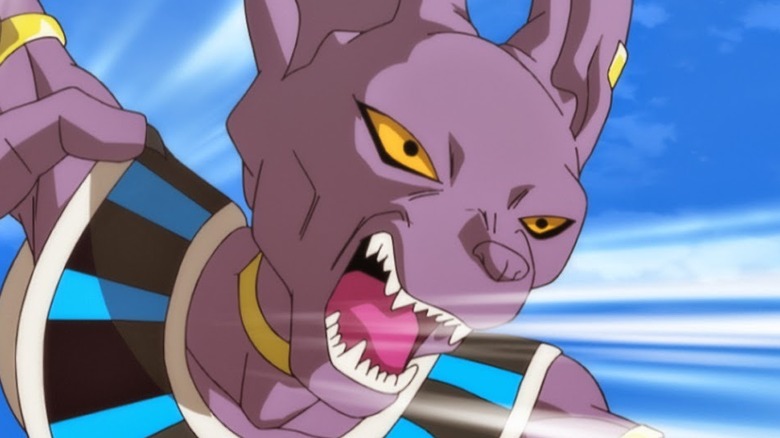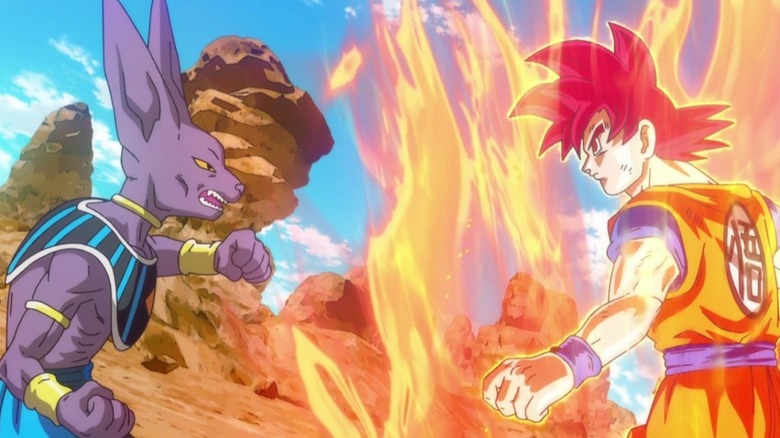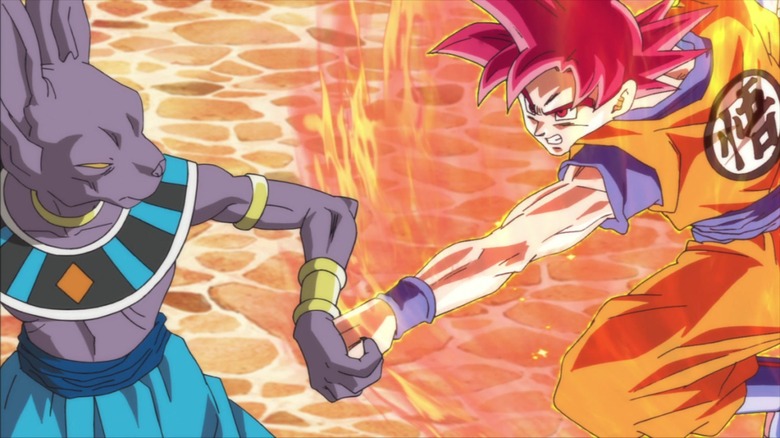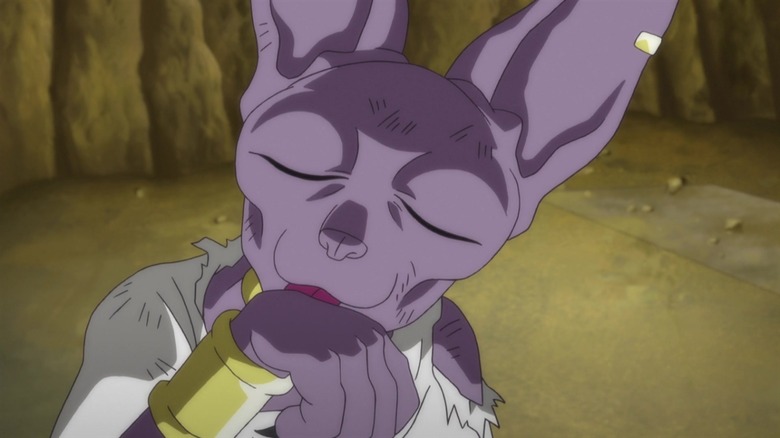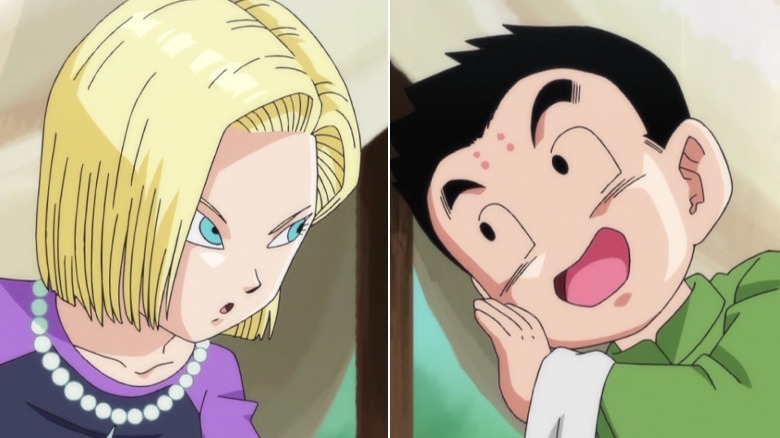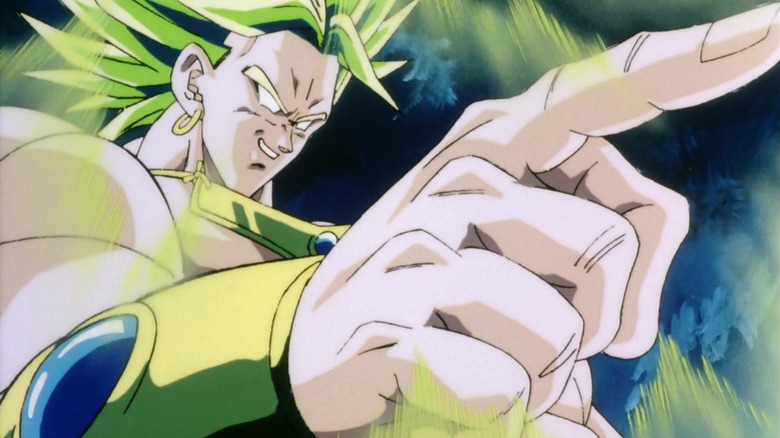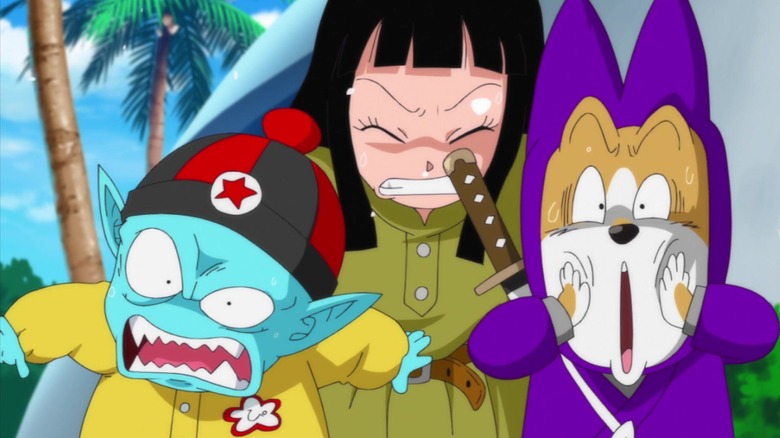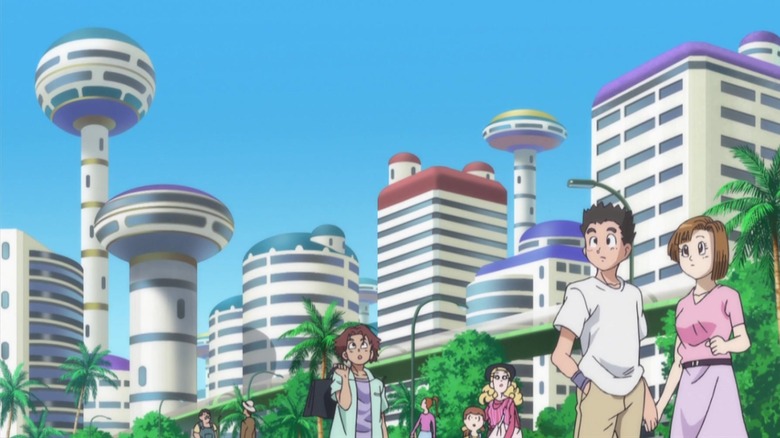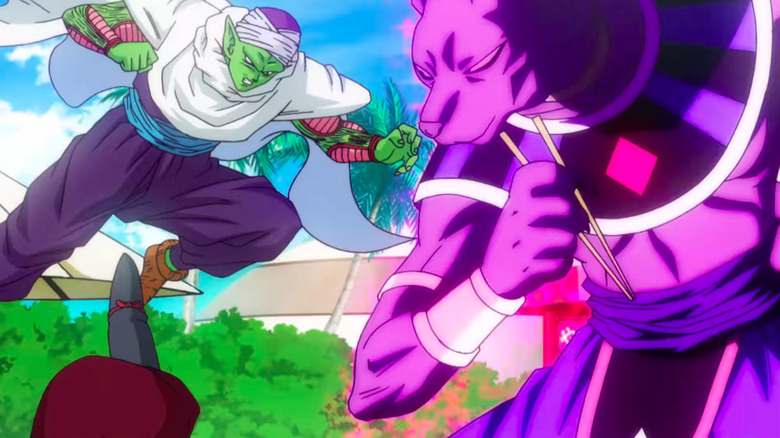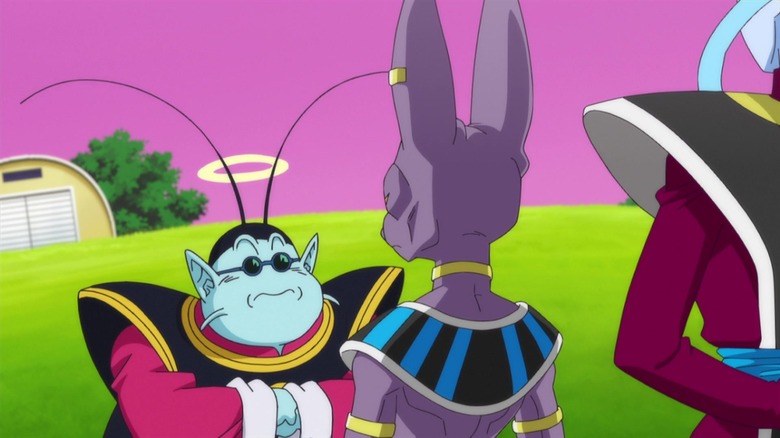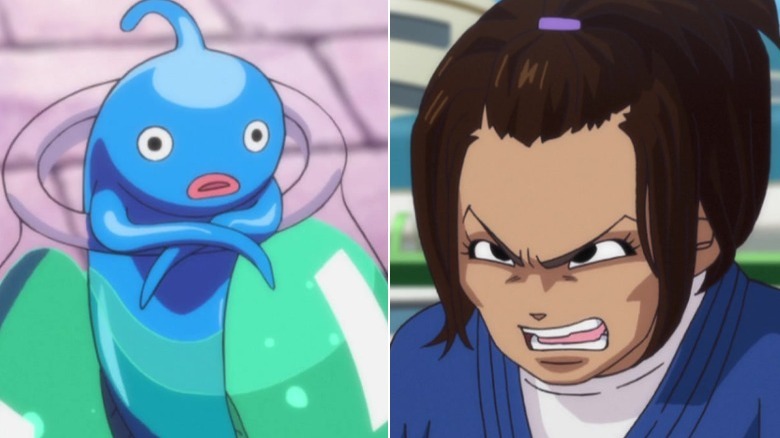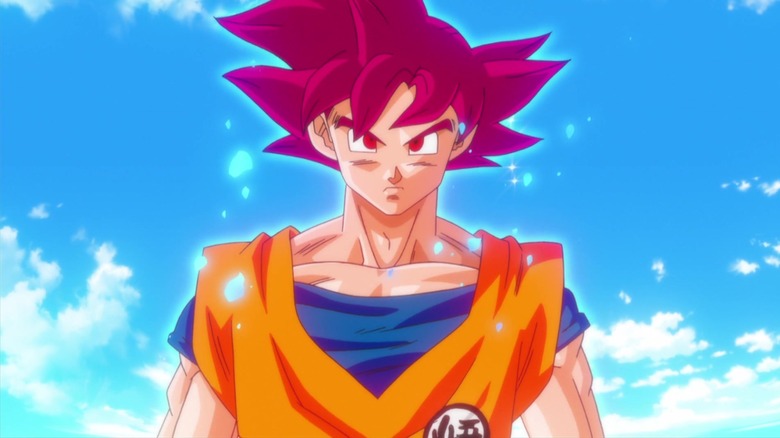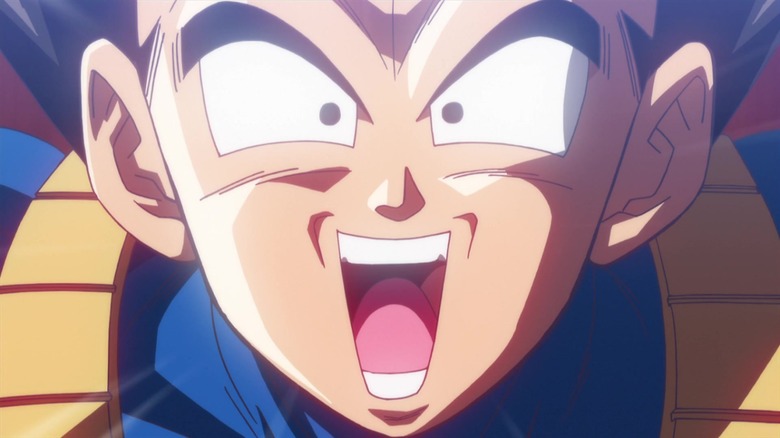How Dragon Ball Z: Battle Of Gods Signaled A New Era And More Facts Fans Will Love
For years, Toei Animation had teased "Dragon Ball" fans with projects like 2008's "Dragon Ball: Yo! Son Goku and His Friends Return!!" and its revamp of "Dragon Ball Z," known as "Dragon Ball Kai." It wasn't until 2013, however, that Akira Toriyama's grand saga finally received a major continuation in the form of "Dragon Ball Z: Battle of Gods." The first theatrical "Dragon Ball" film since "The Path to Power" in 1996, "Battle of Gods" has Beerus, the God of Destruction, and his attendant Whis approach Goku and his friends in hopes of finding (and, of course, fighting) the prophesied "Super Saiyan God." Not only does Goku find out who the Super Saiyan God is — or rather, how to become one — but he also learns of a surprise addition to his family, as well as just how big the "Dragon Ball" cosmos truly is.
To say the movie is a game changer is an understatement, birthing concepts and even characters that'd be further explored in "Dragon Ball Super" and in the movies that followed. It's also a change from previous "Dragon Ball Z" movies in that Akira Toriyama was much more involved in crafting the film's script, leading to him assuming full scripting duties for the movies that followed, starting with "Resurrection 'F.'" Of course, you may already know all of this if you're a dedicated "Dragon Ball" viewer. But could there be certain behind-the-scenes factoids even your Oracle Fish forgot tell you about? Wake up from that decades-long slumber and peer into your attendant staff, because it's time to uncover the facts of "Dragon Ball Z: Battle of Gods."
How Akira Toriyama got involved
One of the things "Battle of Gods" is particularly known for is the heavy participation of Akira Toriyama in crafting the story. Originally, however, it was Yūsuke Watanabe, a screenwriter with a history of adapting manga and anime for live action, who was tasked with crafting the story outline and eventually the script for "Battle of Gods."
So what — or rather, who — brought Toriyama into the fold? As related Toriyama in "Dragon Ball Full Color Comics: Freeza Arc Vol. 4" (translated here by Kanzenshuu), it was none other than Kazuhiko Torishima. Torishima edited Toriyama's early work on "Dragon Ball," as well as the entirety of his other famous long-running manga, "Dr. Slump." On "Battle of Gods," Toriyama made several drastic alterations to Watanabe's plot, even adding in dialogue — turning in, as Watanabe told Ure-Pia Sōken (via Kanzenshuu), a version that was "already finished up like a script."
From there, as he explained to GetNavi magazine (via Kanzenshuu), Watanabe would continue refining the script with Toriyama's feedback until coming up with a version Toriyama was completely happy with. Watanabe described the process as fairly seamless, asserting in DVD & Blu-ray Vision Magazine (also via Kanzenshuu) that the script only bounced around between him and Toriyama "two or three times" before reaching completion.
Super Saiyan God almost looked very different
Super Saiyan God is an interesting departure from the Super Saiyan forms that came before it. Rather than turning a Saiyan's hair gold and their eyes green, it changes both of those features to red, with some black thrown in for the pupils. It also doesn't cause the hair to stand up on end or grow at all, or even bulk a Saiyan up with muscle — if anything, it makes the user slimmer. It's also the only Super Saiyan form that can be obtained by a ritual, though Goku and Vegeta later learn to access the transformation on their own, thanks to Whis' training.
It's pretty counterintuitive as far as Super Saiyan transformations go. It turns out that's entirely deliberate. As Toriyama explained in "Dragon Ball Full Color Comics: Freeza Arc Vol. 5" (via Kanzenshuu), the manga author-turned-screenwriter sought to take the form in a different direction than its predecessors. It may not be surprising to hear that Super Saiyan God looked completely different before Toriyama came onboard. Tadayoshi Yamamuro, the film's animation supervisor and a key contributor to the original "Dragon Ball Z" anime, had come up with a version that, as he described in the "Battle of Gods" Theatrical Program (via Kanzenshuu), was "more muscular, and the hairstyle was about in-between 'Super Saiyan 3' and '[Super Saiyan] 4.'" Yamamuro further goes onto say in an interview with OKWave (via Kanzenshuu) that it would have even given Goku an accessory: a cape.
Beerus is based on Akira Toriyama's cat
It's hard to imagine Beerus looking like anything other than a long-eared cat humanoid, especially since even his habits resemble that of domestic felines. Amazingly, however, Beerus' appearance was originally based more on a lizard's, as Tadayoshi Yamamuro explained to OKWave (via Kanzenshuu). His name, as revealed in a GetNavi magazine interview with Yūsuke Watanabe (via Kanzenshuu), is not based on "beer," as you might expect, but "virus."
Yet like Super Saiyan God, Beerus went through quite a few changes once Toriyama entered the picture. Rather than stick with the lizard inspiration, Toriyama instead redesigned Beerus to resemble his Cornish Rex cat, explaining in "Dragon Ball Chōzenshū 1" (via Kanzenshuu) that his veterinarian likened Toriyama's cat to "some kind of demon" after it recovered from a major ailment. Beerus' attire, as Toriyama related to V-Jump (via Kanzenshuu), was inspired by clothing from Ancient Egypt, whose deities of myth often resembled cats. Toriyama also made Beerus more comedic, Watanabe told DVD & Blu-ray Vision Magazine (via Kanzenshuu).
Naturally, you may be wondering: if Beerus is analogous to "virus," then why does Whis' name sound so similar to a certain alcoholic beverage, namely whiskey? As it turns out, Toriyama also confused the pun behind Beerus' name, as he admitted to Asahi Shimbun Digital (via Kanzenshuu). Rather than course-correct later, however, Toriyama doubled down on the error in "Dragon Ball Super," naming every Angel and God of Destruction after an alcoholic beverage.
The movie almost included a wedding
"Dragon Ball Z: Battle of Gods" occurs on a day that's a pretty big deal for the "Dragon Ball" cast: Bulma's birthday. Though the setting was changed when the movie was adapted in "Dragon Ball Super" from Capsule Corporation to a cruise liner, every version of the story takes place during the scientist extraordinaire's special day.
Originally, however, "Battle of Gods" wasn't going to take place on Bulma's birthday at all. Instead, screenwriter Yūsuke Watanabe had originally set the movie on the day of Android 18 and Krillin's wedding, as he told DVD & Blu-ray Vision Magazine (via Kanzenshuu). Given that the two are married by the time the Buu arc starts, that presumably would have set the film further back in the "Dragon Ball Z" timeline. Toriyama, however, decided to change things up when he joined the creative process, perhaps due to his decision to (as he revealed in "Dragon Ball Z Full Color Comics: Freeza Arc Vol. 4," via Kanzenshuu) have the story take place just a few years before Goku's meeting with Uub. Perhaps one day another "Dragon Ball" movie will finally show us Krillin and 18's matrimony in detail.
How Broly's creator feels about Beerus
While Akira Toriyama did contribute ideas and designs to the "Dragon Ball Z" movies released before "Battle of Gods," he stayed pretty hands-off when it came to scripting. That job fell to Takao Koyama, as the "Dragonbook" included in Dragon Box: The Movies notes (via Kanzenshuu). So it makes sense that Koyama, who also scripted and supervised large portions of the "Dragon Ball" and "Dragon Ball Z" anime, would have a unique view about the first major "Z" theatrical film he didn't have a hand in.
When Koyama delved into his opinions about the movie on his blog (via Kanzenshuu), he focused on a surprising sticking point: how Beerus measures up to major "DBZ" movie villain Broly. Stating that he views the Legendary Super Saiyan as the strongest foe of the original films, Koyama seemingly expressed disappointment that Beerus surpasses Broly so vastly, even if he does feel Broly is still the more menacing-looking one. It's an odd criticism, however, as Koyama himself has created foes whose strength exceeds the original Broly's, including Hirudegarn, Janemba, and Bojack. Hopefully Koyama has found some consolation in Toriyama rebooting Broly as a character much closer to Beerus in power in 2018's "Dragon Ball Super: Broly."
Bringing in the Pilaf Gang was Toriyama's idea
One of the biggest surprises of "Dragon Ball Z: Battle of Gods" was the inclusion of a group of characters who had not appeared in a long time: the Pilaf Gang. In a funny reversal of what happens to them in "Dragon Ball GT," Pilaf, Mai and Shu have accidentally made themselves kids again by asking Shenron to restore their youth, and they decide to snag the Dragon Balls during Bulma's birthday party to change their bodies to the ages they really wanted. Naturally, their plot is foiled, but thanks to their childlike appearance, none of their old foes recognize them, and instead mistake them for harmless youths.
Their appearance feels so fitting for a movie that revisits the world of "Dragon Ball" after so long, that one could easily be forgiven for believing they'd always been a part of it. Surprisingly, though, they weren't in the movie at all until Toriyama entered the picture. As Watanabe spilled in DVD & Blu-ray Vision (via Kanzenshuu), the Dragon Ball nabbers of the film would have been characters specifically created for the movie, rather than familiar figures from the "Dragon Ball" mythos.
Why there's virtually no property damage in Battle of Gods
When you're facing a God of Destruction in battle, they're probably going to live up to their job title. Sure enough, Beerus causes quite a bit of collateral damage whenever he fights in the movie, particularly to poor King Kai's planet. Yet while he and Goku do knock down a few trees and move quite a bit of earth around, neither their fight nor Beerus' battles with Goku's allies upends Capsule Corporation or the nearby West City, even when Goku and Beerus fly through the latter mid-battle.
As it turns out, that detail is no coincidence. As "Battle of Gods" director Masahiro Hosoda mentioned in the "Battle of Gods" Official Movie Guide (via Kanzenshuu), Akira Toriyama gave the filmmakers a very specific directive: "I don't want you to have citywide panic or destruction." The reason, as Yūsuke Watanabe explained in DVD & Blu-ray Vision (via Kanzenshuu), is because Toriyama did not want the movie to depict moments comparable to the destruction Japan endured during the Tōhoku earthquake, which had hit Japan a mere two years before "Battle of Gods" was released in theaters. Watanabe added that Toriyama's decision also influenced the movie's more uplifting tone.
The stuff Toriyama didn't come up with
Toriyama gets a lot of attention and praise for his active role in shaping "Battle of Gods," and rightfully so. Yet plenty of contributions that originated from Watanabe and Toei Animation also made it into the film. The concept of the Super Saiyan God, Watanabe explained to GetNavi magazine (via Kanzenshuu), was being batted around by Toei in the earliest planning stages of the movie, for instance. And while Beerus may have been drastically reworked by Toriyama, it was Watanabe who conceived the original version of the character, as he told DVD & Blu-ray Vision (via Kanzenshuu), along with his name and job description. Making Vegeta the "shadow star" of the movie, in Watanabe's words, was also his idea, as was including Goku's famed catchphrase "Heya! I'm Goku!" from the next episode preview segments of "Dragon Ball Z."
Other notable elements of the movie came, of course, from the animators. While Toriyama designed Whis, movie director Masahiro Hosoda explained to OKWave (via Kanzenshuu) that the character was fine-tuned to be more androgynous and refined at his request. Tadayoshi Yamamuro, meanwhile, was the one who came up with chopsticks as an improvised fighting tool for Beerus, as he stated in his own OKWave interview (via Kanzenshuu).
Beerus' retroactive effect on Dragon Ball lore
It's understandable that a character said to be a "god of destruction" is going to be a major figure in the "Dragon Ball" universe. In almost no time at all, Beerus reveals that he has indeed played a big role in key events throughout the franchise's history. Remember when Frieza blew up Planet Vegeta to avoid an insurrection? He also did it because Beerus asked him. Ever wonder why King Kai's planet is so tiny? Beerus blew up the rest of it when a game of hide-and-seek didn't go his way. And while he clearly missed a few, Beerus also takes credit for severely downscaling Earth's dinosaur population in the film's extended cut.
All of these factoids are revealed in the movie itself. Yet Akira Toriyama has attributed even more big "Dragon Ball" happenings to Beerus in interviews. In June 2014's Saikyō Jump, for example (via Kanzenshuu), Toriyama claimed that Old Kai's Z-Sword imprisonment is also Beerus' doing — an assertion the elder Supreme Kai himself corroborates in the third episode of the "Dragon Ball Super" anime. Who knows what other important moments Beerus had a hand in?
Major celebrities from Japan guest star
Being one of the most popular anime in the world, it's no surprise that "Dragon Ball Z" has at times attracted major star talent. Momoiro Clover Z, for instance, famously voice the various beings guarding Frieza in Earth's Hell in "Dragon Ball Z: Resurrection 'F,'" while in the U.S. James Marsters has played Zamasu in "Dragon Ball Super" and King Piccolo in "Dragon Ball Evolution."
"Battle of Gods" also brings in well-known celebrity personalities. To play the Oracle Fish, the film recruited Shōko Nakagawa, who, as Anime News Network details, has not only played many roles and sung several theme songs for Pokémon (plus the "Gurren Lagan" theme), but has also voiced Saori Kido/Athena in "Saint Seiya Omega" and Rapunzel in the Japanese dub for Disney's "Tangled." Similarly, Kaori "The Beast" Matsumoto, an Olympic gold and bronze medalist and former judo competitor who's since left the profession to start Darcy's, a health-conscious ice cream venue (via Mainichi), plays the police officer who's mighty annoyed when she mistakenly thinks Capsule Corp's causing a ruckus with fireworks. Aside from looking like the real Matsumoto, the officer even has the name "Kaori" written on both sleeves, marking a rare instance in which a real-life person — or at least a version of them — has appeared in "Dragon Ball."
Why Super Saiyan God's hair is red
If you've ever wondered how Toriyama makes decisions regarding hair color and designs for his characters' transformations, the process is actually simpler than you might think, as he explained in the first volume of the Dragon Ball Super Exciting Guide (via Kanzenshuu). The main reason Super Saiyan has gold hair, for example, is because Toriyama wanted his art assistant to avoid the time-consuming process of having to ink Goku's hair all the time. That motivation may also explain why Super Saiyan Goku has green eyes, as well as why so many characters learn to become Super Saiyans as the mostly black-and-white "Dragon Ball" manga goes on.
Similarly, the reasons why Toriyama made a Super Saiyan God's hair red are also pretty simple. His rationale, detailed in "Dragon Ball Full Color Comics: Freeza Arc Vol. 4" (via Kanzenshuu), is that red is a "a strong-looking color" and "easy to understand," in his view. Ironically, in that same interview he also says he doesn't think blue is as strong-looking — a view he clearly reconsidered when introducing Super Saiyan God Super Saiyan (a.k.a. "Super Saiyan Blue") in "Resurrection 'F.'"
Toriyama wanted to keep the movie light
They say there are themes in all works of art, and there are definitely people who would argue the same about the "Dragon Ball" franchise, "Battle of Gods" included. Yet Akira Toriyama would disagree. As he told Shōko Nakagawa (who plays the Oracle Fish) on the "Dragon Ball Z: Battle of Gods" web site (via Kanzenshuu), "The theme is that there is no theme!" Toriyama expanded on this claim in "Dragon Ball Z Full Color Comics: Freeza Arc Vol. 4" (via Kanzenshuu), explaining every story he does, "Battle of Gods" included, deliberately steers clear of underlying messages and even parts that might be overly dramatic or complex.
Like with the property damage, the earthquake was another major factor in Toriyama sticking with levity, as Yūsuke Watanabe told Ure-Pia Sōken (via Kanzenshuu). This, however, was exactly the opposite of what Watanabe had written initially, which was a more serious affair exploring heroism from a philosophical standpoint. Beerus himself was also a more malevolent villain, whom Watanabe had envisioned as the one who'd not only infected the Saiyans with evil (true to his nature as a "virus"), but would do the same to several of Goku's allies in the film, as the screenwriter told DVD and Blu-ray Vision (via Kanzenshuu). Watanabe isn't bitter about the changes, though, even agreeing that everything Toriyama contributed to the script brought it closer to the feel of the franchise.
